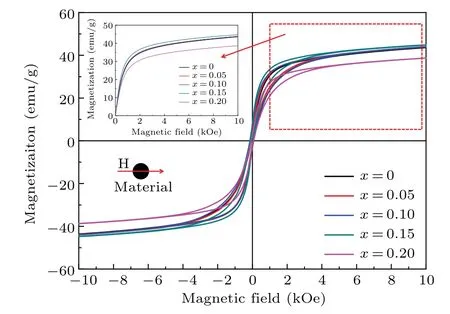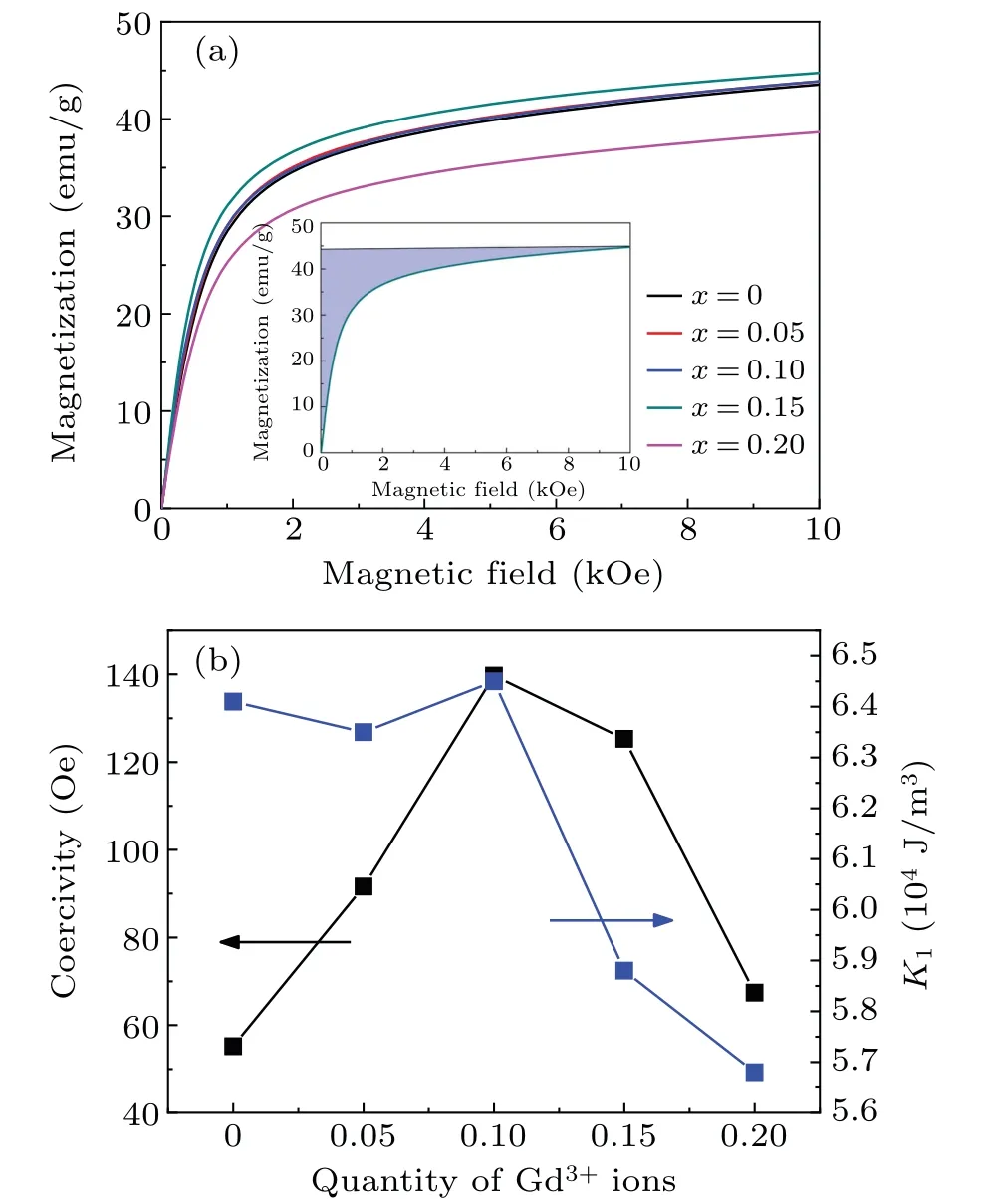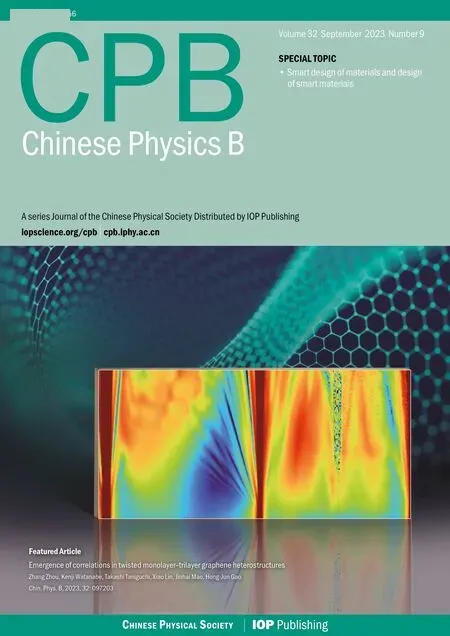Tuning magneto–dielectric properties of Co2Z ferrites via Gd doping for high-frequency applications
Jian Wu(武剑), Bing Lu(卢冰), Ying Zhang(张颖), Yixin Chen(陈一鑫),Kai Sun(孙凯), Daming Chen(陈大明), Qiang Li(李强), Yingli Liu(刘颖力), and Jie Li(李颉),†
1State Key Laboratory of Electronic Thin Films and Integrated Devices,University of Electronic Science and Technology of China,Chengdu 610054,China
2School of Materials Science and Engineering,Hainan University,Haikou 570228,China
3School of Instrument and Electronics,North University of China,Taiyuan 030000,China
Keywords: Co2Z ferrite,magneto–dielectric properties,Gd doping,high-frequency applications
1.Introduction
With the development of communication systems,miniaturization, integration, multi-function, and high-frequency characteristics of electric equipment are becoming more and more important.These requirements have strengthened the research efforts to develop new electronic materials.[1]Hence,the main goals of the research on electronic materials include achieving high-frequency functionality, high performance,and low-temperature sintering process, especially for the requirements of 5G communication and intelligent electronics.Miniaturized antennas and high-frequency filters are important electronic devices for electronic products and systems.[2–4]The materials that make up the filters need to possess excellent performances,including high magnetic permeability,low magnetic loss, and high-frequency function.[5]For miniaturized antennas, the miniaturization factor (N= (µ·ε)1/2) is derived from the following relationship:[6]whereLpis the length of radiating patch,µandεare the magnetic permeability and dielectric permittivity of substrate material,respectively,cis the speed of light in free space,andfris the cut-off frequency.Hence, increasing the value ofµ,ε,andfris the key to reducing the overall size of the antenna.Thus, the utilization of materials with such performances as multilayer filters and antenna substrates should be investigated in more depth.
The Ba3Co2Fe24O41, often denoted as Co2Z, is a ferrite material that has a magnetic easy plane perpendicular to thecaxis,where the magnetic moments can freely rotate.[7]Hence,this material can possess high magnetization, permeability,permittivity, and cut-off frequency.Singhet al.reported the magnetic properties of Co2Z ferrites doped with SiO2and Bi2O3in a frequency range from 1 Hz to 1 MHz.[8]Tranet al.doped Co2Z ferrites with La ions to enhance their microwave absorption and found that La doping endows the ferrites with static magnetic properties and electromagnetic features in a frequency range of 2 GHz–18 GHz.[9]In recent years, many metal ions have been selected for doping Co2Z ferrite materials to adjust their microstructure and magnetic properties,such as Zn2+, La3+, Mg2+, and Cu2+ions.[10–13]Furthermore, in many studies, ferrite was doped with Ba3+ions, thereby affecting its magnetic properties to a certain extent because Ba3+ions are non-magnetic.The magnetic properties of Co2Z materials predominantly originate from total magnetic moment of ferrite and superexchange interaction between magnetic ions.Hence, in the present work, we select rare-earth Gd3+ions to replace Fe3+ions and thus adjust magnetic and dielectric properties of resulting ferrites.The magnetism and magnetic properties of obtained ferrites are also discussed in detail.
2.Experimental details
Ba3Co2Fe24-xGdxO41ferrite materials (x= 0.00, 0.05,0.10,0.15,and 0.20)were prepared via solid-state reaction by using analytical reagent (AR grade,≥99.5%, Aladdin Co.)BaCO3, Co2O3, Fe2O3, and Gd2O3chemicals as raw materials.These chemicals were combined via ball-milling stoichiometrically.They were mixed with deionized water for 16 h.After being dried at 80°C and a heating rate of 2°C/min,these mixtures were pre-sintered at 1200°C for 4 h.Then,2.5-wt%Bi2O3was added and mixed with powders using planetary mill for 12 h.The dried powers were granulated using polyvinyl alcohol (PVA) adhesive and then pressed into 2–3-mm-thick plates and columnar samples.Finally,the materials were sintered at 925°C in air for 4 h.
The phase constitution of the ferrite was identified via xray diffraction(XRD,DX-2700,Haoyuan Co.) using Cu-Kαradiation.The fractured cross sections of the samples were observed via scanning electron microscopy (SEM, JEOL, JSM-6490).Their bulk densities were measured by using an auto density meter (GF-300D, A & D Co.).Their initial magnetization curve and magnetic hysteresis loops were measured by using a vibrating sample magnetometer (VSM, MODEL,BHL-525) in a direct-current (DC) magnetic field ranging from-10 kOe to+10 kOe(1 Oe=79.5775 A·m-1).Complex magnetic permeability and dielectric permittivity of each sample were measured by using an impedance analyzer(E4991B,Agilent).All the measurements were performed at room temperature.
3.Results and discussion
Figure 1 shows the XRD patterns of materials with different quantities of Gd3+ions.Firstly,as shown by the XRD patterns,all samples exhibit a single hexagonal phase,and no other phases are observed.The crystal structure of Z-type hexagonal ferrite is complex and belongs toP63/mmcspace group.[14]The XRD patterns in a range of 28°–32°show that the diffraction peaks shift toward a lower angle for the case of Gd doping,indicating that the lattice constant of the doped material is higher than that of the undoped one.The ionic radius of Gd3+is 0.94 ˚A,which is greater than that of Fe3+ion(0.64 ˚A).Hence,when a small quantity of Gd3+ions are incorporated,they enter into the crystal lattice and occupy the lattice sites, replacing Fe3+ions.As Gd3+ion content increases tox=0.20,the XRD peaks shift toward higher angles,which illustrates that a large number of incorporated Gd3+ions cause lattice distortion.Hence,the XRD results show that Gd3+ions enter into the lattice cells, and no other phases appear, while Gd doping increases the lattice content and causes lattice to be distorted.Additionally,the materials are prepared at low temperature with 2.5-wt%Bi2O3sintering aids.No Bi2O3phase can be seen in the XRD patterns,which shows that Bi2O3sintering aids provide the energy of chemical reaction, and part of Bi2O3is evaporated.

Fig.1.XRD patterns of materials with different quantities of Gd3+ ions.

Fig.2.SEM images and bulk density of materials with different quantities of Gd3+ ions.
The SEM images of materials are shown in Fig.2.These images reveal the presence of hexagonal grains with a plateletlike shape.As Gd3+ion content increases, the grain changes from regular shape into irregular shape.This change is due to the different ionic radii and characteristics of Gd3+and Fe3+ions.The substitution of Gd3+ions for Fe3+ions causes lattice to be distorted, resulting in a change in grain size and shape.The change in grain shape and chemical composition leads to different bulk densities,as shown in Fig.2.With the quantity of Gd3+ions increasing, the bulk density of the investigated ferrite first increases from 4.83 g/cm3(x=0.00)to 5.03 g/cm3(x=0.10) and then decreases to 4.84 g/cm3(x=0.20).The increase in bulk density is predominantly attributed to two factors: (i) the atomic mass of Gd3+ion is greater than that of Fe3+ion, and (ii) there are less pores between grain boundaries whenx=0.10.Whenx=0.15 and 0.20, the decrease in bulk density is mainly due to irregular grain shape and the presence of more pores.Additionally,the pores between grain boundaries hinder domain wall from moving, thereby affecting the magnetic properties.
Grain size distributions of materials with different quantities of Gd3+ions are determined from SEM images and the results are shown in Fig.3.With the quantity of Gd3+ions increasing, the average grain size of materials increases from~2.2 μm (x= 0.00) to~3.5 μm (x= 0.20).This phenomenon can be attributed to the effect of Gd3+ions on the ferrite.Firstly,Gd3+has greater ionic radius than Fe3+,which leads to larger grains.Secondly, more Gd3+ions exist at the grain boundaries, which makes the shape of grains irregular and larger.In addition, Bi2O3sintering aids can provide the energy required for the chemical synthesis of Co2Z ferrites.Bi2O3produces a thick liquid phase,which suppresses graingrowing and widens grain boundary,thereby generating a surface tension force in liquid phase and directly affecting grain size and pores.[15]
Figure 4 shows the magnetic hysteresis loops of materials with different quantities of Gd3+ions,and the inset shows a magnified part of the loops in the magnetic field range ofH= 0 kOe–10 kOe.It can be seen that all samples show relatively smooth hysteresis loops and typical soft magnetic performances.With the quantity of Gd3+ions increasing,saturation magnetization(Ms)of Gd-doped Co2Z ferrite first increases from 43.66 emu/g(x=0.00)to 44.86 emu/g(x=0.15)and then decreases to 38.57 emu/g (x=0.20).In the basic structure of Co2Z ferrite,Fe3+ions are distributed on ten different interstitial sublattices, which consist of the following six octahedral (FeO6) sites: 12kVI, 4fVI, 4eVI, 4fVI*, 12kVI*,and 2aVI,three tetrahedral(FeO4)sites(4eIV,4fIV,and 4fIV*),and one pentahedral(FeO5)site(2bV)for transition metal ions(including Fe and other metal ions).The main origin of the saturation magnetization is related to the total magnetic moment of the ferrite and the Fe3+–O2–Fe3+superexchange interaction in the hyper field at 12k and 4f sites.[16]The Gd is a rare-earth element and also a special ferromagnetic element.Its magnetic moment is contributed by the non-filled 4f7electronic shell.The magnetic moment of the Gd3+ion is 7.94µB,which is larger than that of the Fe3+ion (4.9µB).When the Gd3+ions replace the Fe3+ions,the Gd3+ions preferentially occupy the 2aVIor 4fVIoctahedral sites,which results in an increase in the total magnetic moment of the ferrite.[17]Hence,as the Gd3+ion content increases from 0.00 to 0.15,the saturation magnetization increases.Secondly,Wanget al.reported that the saturation magnetization is related to the density and average grain size of the ferrite.[18]The result is in good agreement with the above-mentioned trend of density.As a result,the increase in density and average grain size are possibly responsible for the increase inMs.However, as the quantity of the Gd3+ions increases further, a part of Gd3+ions occupy 4fIV* tetrahedral sites,resulting in a decrease in the total magnetic moment of the ferrite.The change in the bulk density and the presence of pores present two further reasons for theMsvariation.On the other hand, Bi2O3sintering aid is nonmagnetic, so the addition weakened the overall magnetic properties of the Co2Z ferrite.

Fig.3.Grain size distributions of materials with different quantities of Gd3+ ions.

Fig.4.Magnetic hysteresis loops of materials with different quantities of Gd3+ ions.
For ferrite magnetic materials, the initial magnetization of Co2Z ferrite is related to the magnetocrystalline constantK1.The initial magnetization curves of materials with different quantities of Gd3+sions are shown in Fig.5(a).In the initial magnetization curves, the area surrounded by theM–Hcurve and theMaxis (as shown in the inset of Fig.5(a))represents the magnetocrystalline anisotropy energy.K1can be expressed as the magnetocrystalline anisotropy energy in a unit volume,and obtained from the following equation:
whereVis the crystal cell volume.The value ofK1is calculated based on the results in Fig.5(b).With Gd3+ions doped,theK1value is~6.0×104J/m3.Meanwhile,the different values of coercivity(Hc)of samples are obtained from Fig.5(b).The Gd3+ion doping clearly affects the coercivity of Co2Z ferrite,and the value ofHcfirst increases from 55.2 Oe(x=0.00)to 139.7 Oe(x=0.10)and then decreases to 67.4 Oe(x=0.20).It is found that the coercivity of Z-type barium ferrite is mainly affected by anisotropic field and grain size.[19]Among the possible lattice sites that Gd3+ions can occupy,the 2dvfivefold site has the greatest effect onHc.Therefore,Gd3+ion doping changes the grain size and causesHcto increase.Incorporated Gd3+ions mainly occupy 2aVI,4fVI,and 4fIV* sites, but these occupancies influence lattice position of 2dvsite, leading the lattice to be distorted and affecting the coercivity of material.
For barium ferrite, coercivity is closed related to magnetocrystalline anisotropy.It is found that according to Heisenberg model, the magnetic ion whose orbital is not totally frozen contributes significantly to the magnetocrystalline anisotropy.[20]The magnetic moment of Gd3+ion is larger than that of Fe3+ion.Hence,replacing Fe3+ions with Gd3+ions leads the magnetic properties of the sample to increase slightly but does not cause the number of magnetic ions to increase.Therefore, Gd doping does not cause magnetocrystalline anisotropy constant to change significantly.In addition,it has been reported that the anisotropy of hexaferrite is primarily contributed by Fe3+ions at 2bVsites and Co2+ions.[21]In the above discussion,Gd3+ions mainly occupy 2aVI,4fVI,and 4fIV* sites,which is another reason for the unusual change in magnetocrystalline anisotropy constant.Whenx=0.15 and 0.20,the decrease inK1is due to the presence of small amount of Gd3+ions at grain boundaries and lattice distortion.The contribution of magnetic ions decreases,and the magnetocrystalline anisotropy constant is reduced.

Fig.5.(a) Initial magnetization curves of materials with different quantities of Gd3+ions,with inset showing integration image and(b)variations of coercivity and K1 changes with quantities of Gd3+ ions.
Figure 6 shows the spectra of the real part of magnetic permeability(µ′)and dielectric permittivity(ε′)of Gd-doped Co2Z ferrite in a frequency range from 10 MHz to 1 GHz.For all quantities of Gd3+ions under investigation,the value ofµ′first increases and then decreases before the cut-off frequency.The maximum value ofµ′(~12.2)is found atx=0.15,and this trend is the same as that observed for the saturation magnetization.According to the Globus model,the change in magnetic permeability can be explained according to the following equation:
whereDis the average grain size.Therefore, the change inMsleads the permeability to change.Based on the above discussion, theMsvalue is mainly determined by metal ion occupancy, and theK1value is dictated by the metal ion properties of 2bVsite and 12k site.In addition, the permeability of ferrite is also affected by grain size.As shown in Fig.3,the grain size increases gradually with the quantity of Gd3+ions increasing fromx=0.00 tox=0.15, which contributes to the enhancement of magnetic permeability.The grain is the largest atx=0.20, but shapes of grains are uneven, and several pores can be observed,which negatively affects magnetic permeability.
Figure 6(b) shows the variations of real part of dielectric permittivity (ε′) with frequency of samples.The values ofε′are almost the same for all samples with a pronounced fluctuation between 13.66 and 17.61 in the frequency range of 10 MHz–1 GHz.The Co2Z ferrite withx=0.15 has the highest value ofε′(17.61) in all investigated samples.The higher value ofε′can be explained by Koop’s model,according to which dielectric structure consists of conduction grains separated by resistive grain boundaries.[22]The surface charge polarization at the interface between grains and grain boundaries is responsible for the higherε′value.The good dielectric properties of Co2Z ferrite are due to the hexagonal platelet-like shape particles and the fact that the ion substitution prevents charge from moving.It can be seen that Gd-doped samples exhibit larger grains with more pronounced platelet shape than undoped sample,which provides higher surface area and generates surface polarization.Hence, the value ofε′increases with the quantity of Gd3+ions increasing from 0.00 to 0.15.Whenx=0.20, grains of different shapes and pores provide more hindrance to domain wall motion and grain conduction,which leads to sharp reduction in dielectric constant.
Figure 7 shows the variations of imaginary part of magnetic permeability and imaginary part of dielectric permittivity of materials with the quantity of Gd3+ions.As a result, the magnetic loss tangent (tanδµ) and the dielectric loss tangent(tanδε) are obtained from the equation: tanδµ=µ′′/µ′and tanδε=ε′′/ε′.The values of magnetic loss tangent (tanδµ)and dielectric loss tangent (tanδε) of the materials at different frequencies are shown in Table 1.These loss tangents are defined as tanδµ=µ′′/µ′and tanδε=ε′′/ε′,which indicate magnetic and electric energy loss ability,respectively.For ferrite materials,tanδµis contributed by three main components:hysteresis loss tangent tanδh,eddy current loss tangent tanδe,and residual loss tangent tanδr.[23]The tanδhis the predominant loss at low frequency(in a range of 10 Hz–1 MHz).[10]Hence, the change in magnetic loss at high frequency is attributed to tanδeand tanδr, while tanδeis inversely proportional to the DC resistivity, and tanδris proportional to the grain size of the ferrite.Smaller grains can provide more grain boundaries and enhance the DC resistivity.The Gd doping increases the grain size(as shown in Fig.3),which results in an increase of the resistivity, thereby leading the magnetic loss to increase slightly.Additionally, the change of the resistivity not only increases tanδebut also influences the dielectric loss.The concentration of the Fe3+ions at lattice sites(2aVI,4fVI, and 4fIV* sites)decreases gradually with the Gd3+content increasing.Therefore,the probability of hopping between Fe3+and Fe2+ions is improved, causing the polarization to increase.[24,25]Furthermore, Bi2O3sintering aids bring the thicker grain boundary, affecting the loss.The uneven shape of grain and pore affects the magnetic loss and dielectric loss whenx=0.20.[26]Besides,the low real permeability and real permittivity are another factors influencing the magnetic and dielectric losses.

Table 1.Values of magnetic loss tangent(tanδµ),and dielectric loss tangent(tanδε)at different frequencies.
4.Conclusions
The Z-type ferrite materials, specifically Gd-doped Ba3Co2Fe24-xGdxO41with 2.5-wt%Bi2O3sintering aids,are prepared, and their magnetodielectric properties are investigated.Gd doping does not change the phase of Co2Z ferrite but affects their grain size and shape, contributing to the magnetic and dielectric properties with Gd3+ion substitution.Whenx=0.15, the Ba3Co2Fe22.85Gd0.15O41material processes high saturation magnetization(Ms=44.86 emu/g),low magnetocrystalline anisotropy constant (K1= 5.88×103J/m3),high magnetic permeability(µ′=12.2)and dielectric permittivity (ε′=17.61), and low magnetic loss and dielectric loss in the frequency range from 10 MHz to 1 GHz.The results indicate that the prepared magnetodielectric materials have great potential applications in high-frequency antennas and filters.
Acknowledgements
Project supported by the National Key Research and Development Program of China(Grant No.2022YFB3504800),the National Natural Science Foundation of China (Grant Nos.61901142, 52003256, and 51902037), and the Natural Science Foundation of Shanxi Province, China (Grant No.201901D211259).
- Chinese Physics B的其它文章
- Dynamic responses of an energy harvesting system based on piezoelectric and electromagnetic mechanisms under colored noise
- Intervention against information diffusion in static and temporal coupling networks
- Turing pattern selection for a plant–wrack model with cross-diffusion
- Quantum correlation enhanced bound of the information exclusion principle
- Floquet dynamical quantum phase transitions in transverse XY spin chains under periodic kickings
- Generalized uncertainty principle from long-range kernel effects:The case of the Hawking black hole temperature

